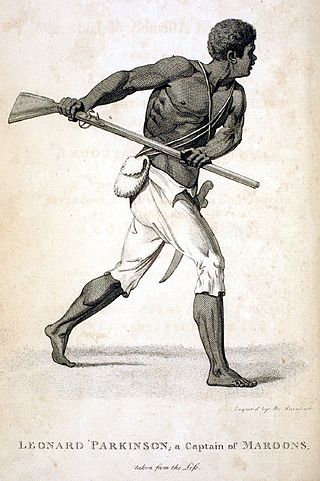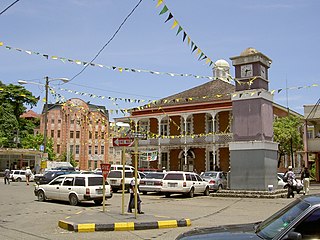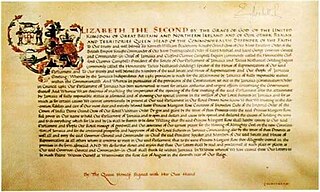Related Research Articles

France began colonizing the Americas in the 16th century and continued into the following centuries as it established a colonial empire in the Western Hemisphere. France established colonies in much of eastern North America, on several Caribbean islands, and in South America. Most colonies were developed to export products such as fish, rice, sugar, and furs.

Spanish Town is the capital and the largest town in the parish of St. Catherine in the historic county of Middlesex, Jamaica. It was the Spanish and British capital of Jamaica from 1534 until 1872. The town is home to numerous memorials, the national archives, and one of the oldest Anglican churches outside England.

Saint Ann is the largest parish in Jamaica. It is situated on the north coast of the island, in the county of Middlesex, roughly halfway between the eastern and western ends of the island. It is often called "the Garden Parish of Jamaica" on account of its natural floral beauty. Its capital is Saint Ann's Bay. Saint Ann comprises New Seville, the first Spanish settlement in Jamaica.

Ocho Rios is a town in the parish of Saint Ann on the north coast of Jamaica, and is more widely referred to as Ochi by locals. Beginning as a sleepy fishing village, Ocho Rios has seen explosive growth in recent decades to become a popular tourist destination featuring duty-free shopping, a cruise-ship terminal, world-renowned tourist attractions and several beaches and acclaimed resorts. In addition to being a port of call for cruise ships, Ocho Rios also hosts cargo ships at the Reynolds Pier for the exportation of sugar, limestone, and in the past, bauxite. The estimated population of the town in 2011 was 16,671, which is nearly 10% of the total population of St. Ann. The town is served by both Sangster International Airport and Ian Fleming International Airport. Scuba diving and other water sports are offered in the town's vicinity.

Maroons are descendants of Africans in the Americas and Islands of the Indian Ocean who escaped from slavery and formed their own settlements. They often mixed with indigenous peoples, eventually evolving into separate creole cultures such as the Garifuna and the Mascogos.

Saint Catherine is a parish in the south east of Jamaica. It is located in the county of Middlesex, and is one of the island's largest and most economically valued parishes because of its many resources. It includes the first capital of Jamaica, Spanish Town, originally known as San Jago de la Vega or Santiago de la Vega.

Port Antonio is the capital of the parish of Portland on the northeastern coast of Jamaica, about 100 km from Kingston. It had a population of 12,285 in 1982 and 13,246 in 1991. It is the island's third largest port, famous as a shipping point for bananas and coconuts, as well as one of its most important tourist attractions, tourism being a major contributor to the town's economy.

Robert Searle was one of the earliest and most active of the English buccaneers on Jamaica.

Rio Grande is a municipality (município) and one of the oldest cities in the Brazilian state of Rio Grande do Sul. It was the state capital from 1835 to 1845. It is the most important port city in the state and has one of the most important maritime ports in Brazil.
William Jackson was an English privateer who, based in Guanaja and Roatan, was in the service of the Providence Island Company from 1639 until around 1641. During that year, he captured a Spanish slave ship at the Honduran port of Trujillo and received a ransom of 8,000 pounds of indigo as well as 2,000 pieces-of-eight and two gold chains. Leaving the Providence Island Company, he sailed to England where he sold sugar and indigo to obtain supplies for another privateering expedition and, upon receiving a three-year letter of marque from the Earl of Warwick, he set sail commanding a fleet including such prominent privateers as Samuel Axe, William Rous and Lewis Morris in 1642.

St. Jago High School in Spanish Town, St Catherine, Jamaica, founded in 1744, is one of the oldest, continuously operated schools in the Western Hemisphere. It is renowned for graduating some of Jamaica's senior military officers, world class cricketers, academic scholars, performing artists, and Olympic athletes.

The Captaincy General of Santo Domingo was the first colony in the New World, established by Spain in 1492 on the island of Hispaniola. The colony, under the jurisdiction of the Real Audiencia of Santo Domingo, was granted administrative powers over the Spanish possessions in the Caribbean and most of its mainland coasts, making Santo Domingo the principal political entity of the early colonial period.

The Anglican Diocese of Jamaica and the Cayman Islands is a diocese of the Church in the Province of the West Indies. It was originally formed as the Diocese of Jamaica, within the Church of England, in 1824. At that time the diocese included the Bahamas and British Honduras ; in 1842, her jurisdiction was described as "Jamaica, British Honduras, the Bahamas". The Bahamas became a separate Diocese in 1861 and British Honduras in 1891. In 2001, the title of the Diocese of Jamaica was extended to include ‘and the Cayman Islands’ to recognise the growth of the Anglican Church in those islands, which had become part of the diocese of Jamaica in the 1960s.

Saint Ann's Bay is a settlement in Jamaica, the capital of Saint Ann Parish. It had a population of 10,961 at the 1991 census.
The western Caribbean zone is a region consisting of the Caribbean coasts of Central America and Colombia, from the Yucatán Peninsula in southern Mexico to the Caribbean region in northern Colombia, and the islands west of Jamaica are also included. The zone emerged in the late sixteenth century as the Spanish failed to completely conquer many sections of the coast, and northern European powers supported opposition to Spain, sometimes through alliances with local powers.

The Invasion of Jamaica took place in May 1655, during the 1654 to 1660 Anglo-Spanish War, when an English expeditionary force captured Spanish Jamaica. It was part of an ambitious plan by Oliver Cromwell to acquire new colonies in the Americas, known as the Western Design.

Santiago was a Spanish territory of the Spanish West Indies and within the Viceroyalty of New Spain, in the Caribbean region. Its location is the present-day island and nation of Jamaica.

The Colony of Jamaica gained independence from the United Kingdom on 6 August 1962. In Jamaica, this date is celebrated as Independence Day, a national holiday.
Howard Kingsley Ainsworth Gregory has served the Anglican Diocese of Jamaica as its bishop since 2012.
References
- ↑ "Arrival of the Spanish in Jamaica". jamaicatimeline.com. Retrieved 2024-01-02.
- ↑ JAMAICAN HISTORY I Archived 2013-08-05 at the Wayback Machine